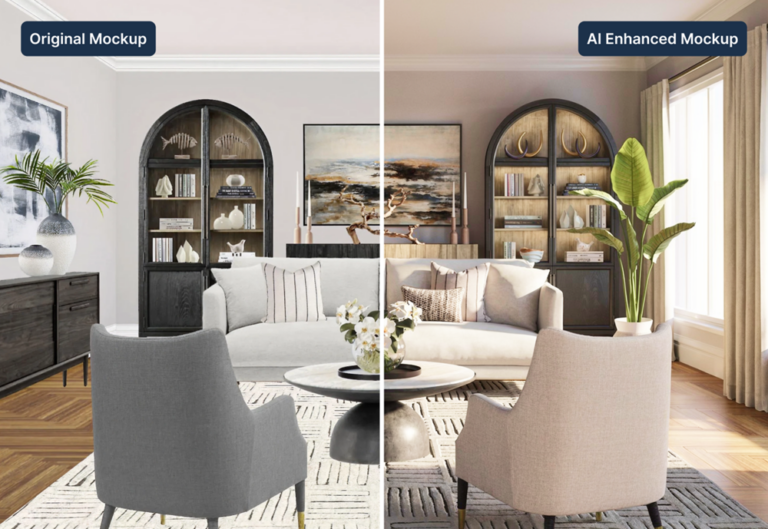Finding efficient tools to bring your creative visions to life is an essential part of running an interior design business, whether you’re at the helm of a huge firm or just starting out. The right design software will enable you to significantly streamline the concepting phase and speed up your creative process.
But with so many design programs on the market, how do you identify the best tools for your own firm? The answer will depend on your unique style, process, and goals. But to help you make an informed choice, let’s start by taking a deeper look into one of the more well-known options—the Spoak Floor Plan tool.
In this guide, will go over what Spoak has to offer as well as alternative options that might be a better fit for professional designers looking for additional tools to support their business needs.
Table of Contents
What can you do with the Spoak Floor Plan tool?
With the Spoak Floor Plan tool, you can create all of the following:
- Floor Plans. The Spoak Floor Plan tool enables you to draw to-scale floor plans, featuring exact measurements. Using its Ruler feature, you can measure distances between objects and tweak your plans as needed. Either build a floor plan from scratch or choose from a selection of prebuilt templates. All floor plans can be customized with a range of finishes and materials.
- Furniture layouts. Pull together a space plan for every room, using either preset furniture and decor options or your own custom selections. Spoak’s simple interface allows you to play and experiment with different layout options and color palettes. You can also incorporate real product images to make your creations even more life-like.
- Elevations. Spoak makes it easy to draw to-scale elevations, which you can populate with your own chosen assets, enabling you and your collaborators to visualize how different elements will look in relation to each other within a room or space.
- Shareable documents. The Spoak Floor Plan tool facilitates collaboration, since you can export and share your floor plans and elevations with clients and contractors.
Spoak’s ease of function makes it a great option for both newbies and seasoned designers alike. But keep in mind, it doesn’t provide all the design and project management tools an interior design business requires. So if you go for this option, we recommend you consider it as a part of your arsenal, rather than an all-in-one solution.
Why seek out an alternative to Spoak’s Floor Plan tool
Spoak offers design and business tools like a floor planner, room mockups, mood boards, and built-in product sourcing, but it’s not nearly as fully featured as other options available on the market.
If you choose Spoak to create designs for your clients, you’ll need to layer on a bunch of other platforms to run your projects and overall business–leading to complex software integrations and expensive monthly subscriptions.
Here are just a few of the features that Spoak lacks:
- Purchase order tracker
- Task management
- Time Tracker
- Digital Contracts
- QuickBooks integration
- Professional-grade floor plans
- 3D rendering
- Extensive 3D models
- Built-in paint library from top brands
- Team collaboration
As you grow your design business, you might find that having a software that includes all the tools you need in one integrated program will better support your business and workflow needs.
5 Alternatives to Spoak’s Floor Plan tool
If you’re looking for a design software with different features and functionality, here are a few of our favorite alternatives.

DesignFiles is a comprehensive interior design platform, providing all the tools—both creative and administrative—that an interior designer requires to run and scale their business. With tools to create all the necessary artistic assets, such as moodboards and floor plans, you can also manage every aspect of your project, from building shopping lists and communicating with clients to tracking time and collecting payments.
Features:
- Moodboard creator (750,000+ products available)
- Paint library including collections from Benjamin Moore, Sherwin Williams, Dulux and Farrow and Ball
- 3D renderings (60,000+ 3D models available)
- Floor planner
- Product clipper for online sourcing
- Sell online design packages
- Send design questionnaires
- Generate shopping lists for clients
- Add affiliate links to boost your income
- Client communication portal
- Digital Contracts
- Task management
- Team collaboration features
- Time tracker
- Project calendar
- Quotes, invoices, and purchase orders
- Accept online payments (both credit card and ACH)
- Quickbooks + Stripe integration
Pros:
- All-in-one solution eliminates the need to invest in multiple platforms.
- Intuitive interface for easy navigation.
- Collaborative tools for easy client and team communication.
Cons:
- No elevations, video or 360° walkthroughs
2. SketchUp

SketchUp combines the satisfying feel of hand-drawing with the convenience of 3D modeling software. This platform enables interior designers to create models of rooms and furnishings from scratch, or to choose from pre-set options. You can also import your own photos, from fabrics and wallpaper to flooring and accessories for a more lifelike final result.
Features:
- 3D modeling
- Object library
- Materials library
- Virtual reality crossover.
Pros:
- Great for designers who love the process of drawing by hand.
- Compatible with virtual reality platforms for an even more immersive experience.
Cons:
- Requires an annual subscription for full functionality.
- No project management features.
3. Homestyler

Homestyler is a cloud-based platform that allows users to create 3D floor plans, models, and renderings. You can decorate your room designs with pre-selected furnishings from their model library, and view them with photo-realistic clarity.
Features:
- Cloud-based
- 3D renderings
- 300,000+ 3D models and materials
- Photo-realistic images, panoramas, and animated videos.
- Virtual reality tours.
Pros:
- Multiple visualization options.
- You can easily access and share your designs from anywhere.
Cons:
- No project management features.
4. Coohom

Coohom is a 3D modeling software platform, through which you can draw floor plans, furnish rooms from an abundant model library, and produce photo-realistic images and videos.
Features:
- Floor plan creator
- 3D rendering
- 3D model library (750,000+ products)
Pros:
- Multiple visualization options.
- Great for those who enjoy drawing by hand.
Cons:
- No project management features.
5. RoomSketcher

RoomSketcher is a floor plan tool allowing users to either draw their own floor plans via an app or order floor plans created by expert illustrators.
Features:
- Done-for-you floor plans.
- 3D renderings.
Pros:
- Intuitive and beginner-friendly
- Realistic 3D visualization
Cons:
- Limited customization options compared to some other tools
- Not suitable for complex professional projects
- No project management features
Frequently asked questions about Spoak
Unfortunately, Spoak isn’t reviewed on popular review sites like G2, Capterra, or Trustpilot. There is a short thread on Reddit, where a homeowner describes using the tool to help manage DIY design. You can also find a detailed review on Business Insider from another homeowner.
But you won’t find online reviews from professionals, as the tool is more commonly used by consumers.
Spoak does not offer a free plan. You can sign up for a 7-day free trial of any of their subscriptions. The lowest-cost plan for homeowners is $9.99 per month, and the lowest-cost plan for professionals is $34.99 per month.
Plans don’t require long-term contracts and can be canceled at any time.
For professional interior designers, the top alternatives include DesignFiles, SketchUp, and Coohom. Homestyler and RoomSketcher are better options for homeowners looking to DIY their spaces.
Spoak offers three monthly plans for individual homeowners: Play for $9.99, Plus for $19.99, and Power for $29.99. The more you pay, the more designs and assets you unlock.
Spoak also offers three monthly plans for professionals: Pro for $34.99, Premium for $99.99, and custom enterprise pricing. The main difference between Pro and Premium is that Premium offers more projects.
When comparing Spoak versus SketchUp, Spoak is a clear winner for DIY homeowners because SketchUp has a steep learning curve.
When it comes to professional designers, the answer isn’t as straightforward. Opt for SketchUp if you want to create highly customized designs and offer clients photorealistic renderings. Go for Spoak if you want an easy-to-use tool and would rather sacrifice customization to save time on projects.
Stacking up Spoak versus DesignFiles, there are several main differences. Spoak targets DIYers and interior designers who are just launching their businesses. It lacks essential features that pro designers need, such as a time tracker, task manager, and browser-based product clipper.
The biggest difference, however, is that DesignFiles offers unlimited projects on all paid plans (starting at $49 per month), but with Spoak, you need to speak with sales and purchase a custom enterprise plan to unlock unlimited projects.
One of the most common uses of Spoak is to create a moodboard. To use Spoak, click the “Join” button at the top right-hand corner of the website. Then select the plan that you want to trial. Then navigate to the design tools, and select “Editorial” to create a moodboard. Next, select the template you want to use, such as “Vibe” and replace the images you see with your own.
No, Spoak does not offer iOS or Android apps, but the platform is optimized for use on web browsers across all devices, meaning you can login and give it a go on your tablet or phone. Just use your favorite web browser to access the site.
Key takeaways
Investing in software solutions to streamline systems and processes is crucial for any interior designer to grow and thrive.
In our experience, we’ve observed that providing clients with the ability to visualize their desired outcomes early on significantly enhances their satisfaction and alleviates stress throughout the design journey. This proactive approach not only fosters client happiness, but also contributes to a more seamless and efficient design process for all stakeholders involved. It’s a win-win!
At the same time, an interior design business is about so much more than the visuals. A platform that provides project management functionality will make a huge difference in your ability to keep projects organized and on schedule. Streamlining your systems will also enable you to spend less time on the grunt admin work and more time on design.
Whether you go for the Spoak Floor Plan tool, an all-in-one platform, or a combination, we hope you find the perfect plan for your business.
Get the best features under one roof. Learn more about DesignFiles, the top-rated platform for interior designers.

![Top 7 Interior Design Project Management Software [2026 Guide]](https://blog.designfiles.co/wp-content/uploads/2024/06/AdobeStock_215623020-768x512.jpeg)
